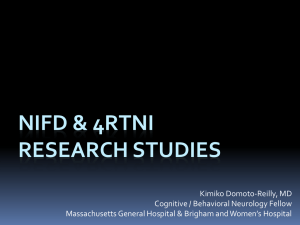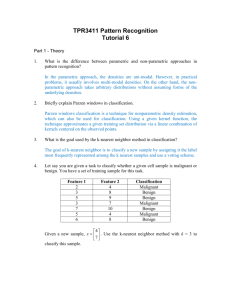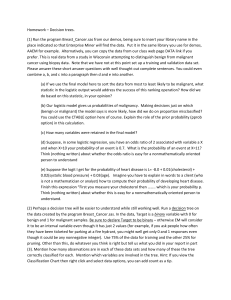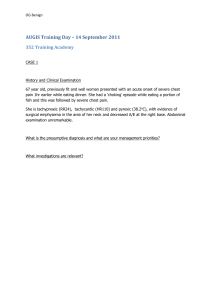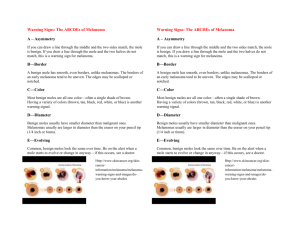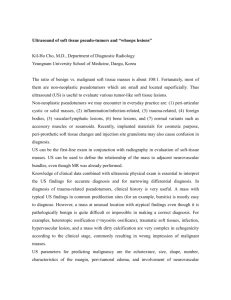Supplementary Information (doc 3177K)
advertisement
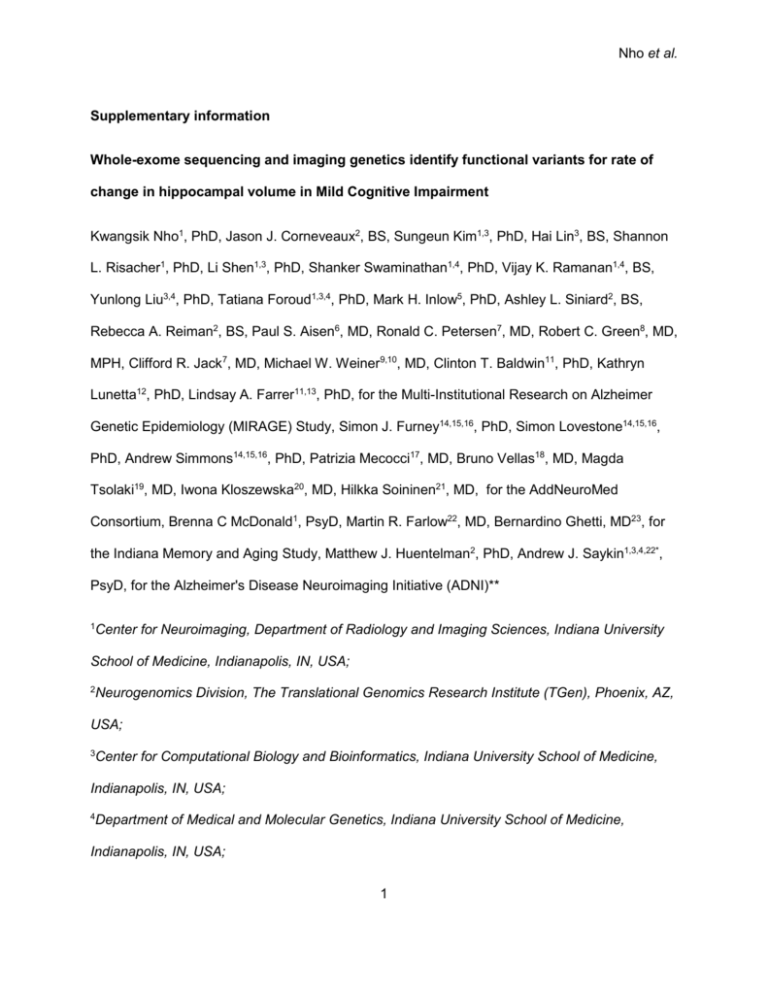
Nho et al. Supplementary information Whole-exome sequencing and imaging genetics identify functional variants for rate of change in hippocampal volume in Mild Cognitive Impairment Kwangsik Nho1, PhD, Jason J. Corneveaux2, BS, Sungeun Kim1,3, PhD, Hai Lin3, BS, Shannon L. Risacher1, PhD, Li Shen1,3, PhD, Shanker Swaminathan1,4, PhD, Vijay K. Ramanan1,4, BS, Yunlong Liu3,4, PhD, Tatiana Foroud1,3,4, PhD, Mark H. Inlow5, PhD, Ashley L. Siniard2, BS, Rebecca A. Reiman2, BS, Paul S. Aisen6, MD, Ronald C. Petersen7, MD, Robert C. Green8, MD, MPH, Clifford R. Jack7, MD, Michael W. Weiner9,10, MD, Clinton T. Baldwin11, PhD, Kathryn Lunetta12, PhD, Lindsay A. Farrer11,13, PhD, for the Multi-Institutional Research on Alzheimer Genetic Epidemiology (MIRAGE) Study, Simon J. Furney14,15,16, PhD, Simon Lovestone14,15,16, PhD, Andrew Simmons14,15,16, PhD, Patrizia Mecocci17, MD, Bruno Vellas18, MD, Magda Tsolaki19, MD, Iwona Kloszewska20, MD, Hilkka Soininen21, MD, for the AddNeuroMed Consortium, Brenna C McDonald1, PsyD, Martin R. Farlow22, MD, Bernardino Ghetti, MD23, for the Indiana Memory and Aging Study, Matthew J. Huentelman2, PhD, Andrew J. Saykin1,3,4,22*, PsyD, for the Alzheimer's Disease Neuroimaging Initiative (ADNI)** 1 Center for Neuroimaging, Department of Radiology and Imaging Sciences, Indiana University School of Medicine, Indianapolis, IN, USA; 2 Neurogenomics Division, The Translational Genomics Research Institute (TGen), Phoenix, AZ, USA; 3 Center for Computational Biology and Bioinformatics, Indiana University School of Medicine, Indianapolis, IN, USA; 4 Department of Medical and Molecular Genetics, Indiana University School of Medicine, Indianapolis, IN, USA; 1 Nho et al. 5 Department of Mathematics, Rose-Hulman Institute of Technology, Terre Haute, IN, USA; 6 Department of Neurosciences, University of California, San Diego, San Diego, CA, USA; 7 Mayo Clinic, Rochester, MN, USA; 8 Division of Genetics, Department of Medicine, Brigham and Women's Hospital and Harvard Medical School, Boston, MA, USA; 9 Departments of Radiology, Medicine and Psychiatry, University of California, San Francisco, San Francisco, CA, USA; 10 Department of Veterans Affairs Medical Center, San Francisco, CA, USA; 11 Biomedical Genetics, Boston University School of Medicine, Boston, MA, USA; 12 Department of Biostatistics, School of Public Health, Boston University, Boston, MA, USA; 13 Genetic Epidemiology Center, Boston University School of Medicine, Boston, MA, USA; Institute of Psychiatry, King’s College London, London, UK; 14 15 NIHR Biomedical Research Centre for Mental Health at South London and Maudsley NHS Foundation Trust and Institute of Psychiatry, King’s College London, UK; 16 NIHR Biomedical Research Unit for Dementia at South London and Maudsley NHS Foundation Trust and Institute of Psychiatry, King’s College London, UK; 17 Institute of Gerontology and Geriatrics, University of Perugia, Perugia, Italy; 18 Toulouse Gerontopole University Hospital, Universite Paul Sabatier, INSERM U 558, Toulouse, France; 19 Third Department of Neurology, Aristotle University of Thessaloniki, Thessaloniki, Greece; 20 Department of Old Age Psychiatry & Psychotic Disorders, Medical University of Lodz, Lodz, Poland; 2 Nho et al. 21 Department of Neurology, University of Eastern Finland, Kuopio University Hospital, Kuopio, Finland; 22 Department of Neurology, Indiana University School of Medicine, Indianapolis, IN, USA 23 Department of Pathology and Laboratory Medicine, Indiana University School of Medicine, Indianapolis, IN, USA * Please address correspondence to: Andrew J. Saykin, PsyD Department of Radiology and Imaging Sciences, Center for Neuroimaging, Indiana University School of Medicine, Indianapolis, IN, USA Phone: 317-963-7501; Fax: 317-963-7547; E-mail: asaykin@iu.edu Running title: Whole exome sequencing in MCI **Data used in preparation of this article were obtained from the Alzheimer’s Disease Neuroimaging Initiative (ADNI) database (adni.loni.ucla.edu). As such, the investigators within the ADNI contributed to the design and implementation of ADNI and/or provided data but did not participate in analysis or writing of this report. A complete listing of ADNI investigators can be found at: http://adni.loni.ucla.edu/wpcontent/uploads/how_to_apply/ADNI_Acknowledgement_List.pdf 3 Nho et al. Supplementary Table ST1 WES sample demographics Slow group Rapid group P Number of samples 8 8 − Age at baseline 74.9±6.6 74.0±8.0 0.82 Education (years) 15.4±2.4 15.4±2.4 1 Slope 0.15±0.97 -5.27±1.59 <0.001 Average APC 0.16±0.99 -4.99±1.71 <0.001 MMSE 27.9±1.8 26.6±2.1 0.22 Abbreviation: APC, Annual percentage of change; MMSE, Mini-mental state examination. 4 Nho et al. Supplementary Table ST2 ADNI-1 sample demographics Slow group Rapid group All WES sample All MCI All ε3/ε3 8 8 16 347 316 Age 74.9 (6.6) 74.0 (8.0) 74.4 (7.1) 74.9 (7.3) 76.3 (7.2) education 15.4 (2.4) 15.4 (2.4) 15.4 (2.4) 15.7 (3.0) 15.9 (3.0) Sex (M, F) 8, 0 8, 0 16, 0 217, 130 183, 133 Handedness (R, L) 8, 0 8, 0 16, 0 313, 34 284, 32 ApoEGrp (+,-) 0, 8 0, 8 0, 16 199, 148 0, 316 MMSE 27.9 (1.8) 26.6 (2.1) 27.3 (2.0) 27.1 (1.8) 27.3 (2.6) Global CDR 0.5 (0.0) 0.5 (0.0) 0.5 (0.0) 0.50 (0.03) 0.3 (0.3) CDR-Sum of Boxes 1.4 (0.7) 1.6 (0.9) 1.5 (0.8) 1.6 (0.9) 1.4 (1.7) RAVLT total score 31.1 (4.2) 24.9 (5.9) 28.0 (5.9) 30.9 (9.3) 35.0 (11.6) Boston Naming Test 26.6 (2.8) 25.9 (4.3) 26.3 (3.5) 25.5 (4.1) 25.9 (5.0) Fluency-Animals 17.9 (5.6) 13.4 (3.9) 15.6 (5.2) 16.1 (4.9) 17.3 (6.2) Fluency-Vegetables 12.3 (2.5) 9.1 (2.3) 10.7 (2.8) 10.8 (3.5) 12.0 (4.7) Trail A 52.4 (40.6) 45.0 (23.4) 48.7 (32.2) 44.1 (22.0) 46.5 (28.6) Trail B 128.9 (86.4) 160.3 (80.4) 144.6 (82.2) 130.1 (74.0) 121.4 (78.1) N 5 Nho et al. Supplementary Table ST3 Sequencing and mapping statistics for 16 exomes SubjID Total reads Aligned reads Aligned bases HQ aligned Q20 bases (M) (M) (B) (B) Mismatch rate Mean target coverage Fold enrichment PCT target bases 30X 08AD6520 184.2 152.7 11.9 11.4 0.0038 162 41 0.82 08AD6533 159.8 132.6 10.4 9.9 0.0037 139 40 0.80 08AD6543 214.1 175.6 13.8 13.2 0.0036 185 40 0.82 08AD6611 148.7 122.2 9.5 9.1 0.0037 126 40 0.79 08AD6795 118.5 98.1 7.7 7.4 0.0035 103 40 0.77 08AD6863 138.0 113.8 9.0 8.6 0.0035 123 41 0.78 08AD7023 125.2 103.7 8.2 7.9 0.0035 113 41 0.77 08AD7133 145.4 121.1 9.5 9.2 0.0035 126 40 0.79 08AD6596 169.7 140.1 10.9 10.5 0.0038 146 40 0.80 08AD6663 214.0 176.7 13.7 13.2 0.0038 179 39 0.82 08AD6679 157.5 130.3 10.2 9.7 0.0037 135 40 0.79 08AD6786 165.1 135.6 10.5 10.1 0.0038 137 39 0.80 08AD6804 90.6 115.0 9.1 8.7 0.0035 119 39 0.79 08AD6858 178.2 146.3 11.5 11.1 0.0035 153 40 0.81 08AD7092 179.6 149.7 11.8 11.3 0.0035 155 39 0.81 08AD7125 191.9 159.6 12.6 12.1 0.0035 170 40 0.82 6 Nho et al. Supplementary Table ST4 Variants identified by whole-exome sequencing SNV Exonic Indel 50,396 Exonic 613 Non-synonymous 25,144 Frameshift 382 Synonymous 25,234 Non-frameshift 231 Unknown 18 Splicing 945 Splicing 82 Intronic 29,236 Intronic 3,082 Intergenic 1,785 Intergenic 165 Others 7,037 Others 602 7 Nho et al. Supplementary Table ST5 Exonic variants unique to the rapid group (cases) but not found in the slow group (controls). chr 1 22 7 7 20 2 1 1 1 3 1 17 1 22 18 2 1 3 7 8 14 20 21 3 1 16 14 15 2 SNV ID genename rs1136410 PARP1 rs9610775 CARD10 rs6949082 HYAL4 rs3735400 ANLN rs34323943 ZNF217 rs1042821 MSH6 rs857685 OR10Z1 rs12731961 CAPN9 rs41273491 OR6Y1 rs4685076 TMEM43 rs12568050 ZNF648 rs3744395 TEKT1 rs857725 SPTA1 rs68178377 FAM116B rs17732496 TXNDC2 rs2276551 FAM179A rs12564283 ZNF648 rs2340917 TMEM43 rs1129771 SKAP2 rs17335870 SPAG1 rs17180350 SPTB rs6063966 ZNF217 rs6586239 RIPK4 rs12163565 DNAH1 rs11209026 IL23R rs113388806 TNRC6A rs45527334 SAMD15 rs62026667 SHF rs1800440 CYP1B1 functional only in case probably 6 probably 6 benign 6 probably 5 probably 5 probably 5 possible 5 possible 5 benign 5 benign 5 benign 5 benign 5 benign 5 benign 5 benign 5 benign 5 benign 5 benign 5 benign 5 benign 5 benign 5 benign 5 benign 5 benign 5 probably 4 probably 4 probably 4 probably 4 probably 4 homo 1 1 2 1 0 0 1 1 2 1 0 0 1 1 0 0 0 1 0 1 1 0 2 1 1 0 0 0 1 hetero 5 5 4 4 5 5 4 4 3 4 5 5 4 4 5 5 5 4 5 4 4 5 3 4 3 4 4 4 3 chr 1 6 1 11 17 8 2 9 7 20 1 4 4 2 14 3 22 20 16 20 1 7 8 15 15 15 21 21 8 SNV ID rs855314 rs12191414 rs17369441 rs11222085 rs2289530 rs1137806 rs33993717 rs818711 rs34111764 rs55786258 rs15786 rs147709711 rs4963 rs35228363 rs17776256 rs2227998 rs760749 rs34419428 rs4988483 rs56057707 rs34554682 rs5763 rs11545077 rs7170637 rs11549015 rs16963151 rs2837029 rs11575939 genename PGM1 POM121L2 AXDND1 ADAMTS8 CCDC40 FAM83H MFSD9 BSPRY PARP12 ZNF831 ATP13A2 FRAS1 ADD1 ALK C14orf101 XPC MOV10L1 SLCO4A1 SSTR5 ZNF831 MAEL TBXAS1 GGH CYFIP1 EHD4 ATP8B4 LCA5L SH3BGR functional only in case possible 4 possible 4 possible 4 possible 4 possible 4 possible 4 possible 4 possible 4 possible 4 benign 4 benign 4 benign 4 benign 4 benign 4 benign 4 benign 4 benign 4 benign 4 benign 4 benign 4 benign 4 benign 4 benign 4 benign 4 benign 4 benign 4 benign 4 benign 4 homo 1 0 0 0 1 2 1 0 0 0 1 0 1 1 0 0 0 0 1 0 0 0 2 0 1 0 0 0 hetero 3 4 4 4 3 2 3 4 4 4 3 4 3 3 4 4 4 4 3 4 4 4 2 4 3 4 4 4 Nho et al. Functional: Polyphen2 was used to predict potential impact on protein structure or function of missense variants. Homo, hetero: number of subjects who are homozygous or heterozygous for the minor allele. 9 Nho et al. Supplementary Figure SF1. Forest plots of meta-analysis result for rs1136410 (a) Left Hippocampal Volume Studies Standardized Mean Difference (95% CI) ADNI-1 ADNI-GO-2 IMAS AddNeuroMed 0.253 0.319 -0.292 0.391 (0.001, 0.504) (0.015, 0.623) (-0.971, 0.387) (-0.001, 0.782) MIRAGE 0.219 (-0.063, 0.501) Overall 0.253 (0.109, 0.398) (b) Right Hippocampal Volume Studies ADNI-1 ADNI-GO-2 IMAS AddNeuroMed MIRAGE Overall Standardized Mean Difference (95% CI) 0.139 0.293 0.046 0.279 0.070 0.170 (-0.112, 0.390) (-0.011, 0.596) (-0.630, 0.722) (-0.111, 0.669) (-0.211, 0.352) (0.027, 0.315) 10 Nho et al. Supplementary Figure SF2. Mean difference of left hippocampal volume at baseline for rs1136410 11 Nho et al. Supplementary Figure SF3. Mean difference of right hippocampal volume at baseline for rs1136410 12 Nho et al. Supplementary Methods Alzheimer’s Disease Neuroimaging Initiative (ADNI) The initial phase (ADNI-1) was launched in 2003 to test whether serial magnetic resonance imaging (MRI), position emission tomography (PET), other biological markers, and clinical and neuropsychological assessment could be combined to measure the progression of MCI and early AD. ADNI was intended to aid researchers and clinicians develop new treatments for MCI and early AD, monitor their effectiveness, and lessen the time and cost of clinical trials. This multi-site longitudinal study was supported by the National Institute on Aging (NIA), the National Institute of Biomedical Imaging and Bioengineering (NIBIB), the Food and Drug Administration (FDA), private pharmaceutical companies and non-profit organizations. The ADNI participants were recruited from 59 sites across the U.S. and Canada and include approximately 200 cognitively normal older individuals (healthy controls (HC)), 400 patients diagnosed with MCI, and 200 patients diagnosed with early probable AD aged 55-90 years. ADNI-1 has been extended to its subsequent phases (ADNI-GO and ADNI-2) for follow-up for existing participants and additional new enrollments. Genotyping was performed using the Human610-Quad BeadChip for the ADNI-1 participants and the HumanOmni Express BeadChip for participants initially enrolled in ADNI-GO or ADNI-2. Inclusion and exclusion criteria, clinical and neuroimaging protocols, and other information about ADNI have been published previously and can be found at www.adni-info.org.1-3 Demographic information, raw scan data, APOE and GWAS genotypes, neuropsychological test scores, and diagnostic information are available from the ADNI clinical data repository (http://www.loni.ucla.edu/ADNI/). AddNeuroMed Consortium 13 Nho et al. The AddNeuroMed study is a prospective and longitudinal multicenter collaboration for the discovery of novel biomarkers for AD.4, 5 Data were collected from six medical centers across Europe. Informed consent was obtained for all subjects, and the study was approved by the relevant institutional review board at each data acquisition site. A total of 281subjects (94 AD, 96 MCI, and 91 healthy controls (HC)) were genotyped and had MRI scans. All samples from the AddNeuroMed study were genotyped using the Illumina Human610-Quad BeadChips. Their genotyping was conducted as described previously.5 APOE genotyping was separately obtained using standard methods to yield the APOE allele defining SNPs (rs429358, rs7412).5 Multi-Institutional Research on Alzheimer Genetic Epidemiology (MIRAGE) Study The MIRAGE study is a family-based genetic epidemiological study of AD, which contains primarily discordant sibling pairs. Enrollment, data collection, and diagnostic procedures were described in detail elsewhere.6 The MIRAGE participants were genotyped on the Illumina Infinium Human 610-Quad BeadChip (approximately 2/3 of participants) and the Illumina Infinium HumanCNV370-Duo BeadChip (the remaining participants). Genotyping for the APOE ε2/ε3/ε4 alleles were performed separately.7 We first chose individuals with APOE ε3/ε3 from all MIRAGE participants and then chose one person from each family at random. Indiana Memory and Aging Study (IMAS) The IMAS is an IRB-approved ongoing project on memory circuitry in AD and MCI at the Indiana University School of Medicine. The sample included individuals with significant cognitive complaints without performance deficits, amnestic MCI, healthy controls, and AD. Genotyping was performed using the HumanOmni Express BeadChip and APOE genotyping was separately obtained using standard methods to yield the APOE allele defining SNPs (rs429358, rs7412). 14 Nho et al. Participant recruitment, selection criteria, and characterization were described in detail elsewhere.8 Genotyping and Quality Control Procedures All subjects used in this study are participants of ADNI. Written informed consent was obtained at the time of enrollment for imaging and genetic sample collection and protocols of consent forms were approved by each participating sites’ Institutional Review Board (IRB). A majority of ADNI-1 participants (818 out of 822) were genotyped using the Illumina Human610-Quad BeadChip. Their genotyping was conducted as described previously.9 A total of 818 subjects (188 AD, 401 MCI and 229 HC at baseline) were included in the present analyses. We performed standard quality control procedures for genetic markers and subjects as described previously.9, 10 Since population stratification is known to cause spurious association in disease studies, we restricted our analyses to only subjects that clustered with CEU (Utah residents with Northern and Western European ancestry from the CEPH collection) + TSI (Toscani in Italia) populations using HapMap 3 genotype data and the multidimenstional scaling (MDS) analysis (www.hapmap.org). Consequently, 750 individuals and 531,096 SNPs passed all quality control tests and the total genotyping rate in the remaining subjects was > 99.5%. Whole exome sequencing analysis Targeted capture and exome sequencing: Whole-exome sequencing was performed on blood-derived genomic DNA samples obtained from 16 MCI patients. Sequences were enriched through hybridization using the Agilent’s SureSelect Human All Exon 50Mb kit following the manufacturer’s protocol (www.genomics.agilent.com/). The Agilent kit captured an exome that was approximately 50Mb in size, covering ~21,000 genes. These samples could then be sequenced together on one lane of the flowcell and segregated later for analysis using their molecular bar-codes as tags. Samples were sequenced across multiple flowcell lanes to 15 Nho et al. account for any possible lane effects. These libraries were sequenced on the Illumina HiSeq2000 using paired-end read chemistry and read lengths of at least 105bp (www.illumina.com). Each sample was sequenced two times and the two sequencing data sets were merged after alignment. Sequence alignment: For each lane in the DNA sequencing output, the resulting Illumina qseq files were converted into fastq files, a text-based format for storing both sequence reads and their corresponding quality information in Phred format. Short-read sequences in the targeted region were mapped to the NCBI reference human genome (build 37.64) with the BWA software (Burrows-Wheeler Aligner), allowing for up to two mismatches in each read.11 The quality check on raw sequence data showed that as expected, the 5’ end of each read contained significantly more error than the 3’ end, i.e., error rates increased with the position along sequencing read. Hence, during the alignment, we used only bases with Phred Quality > 15 in each read to include soft clipping of low-quality bases. After the alignment, only those uniquely mapped pairend reads were retained. After completing initial alignment, the alignment was refined by locally realigning of any suspicious reads likely to require realignment using Genome Analysis ToolKit (GATK) (http://www.broadinstitute.org/gsa/wiki/index.php/GATK). After local realignment, reads from molecular duplicates were removed. The reported base calling quality scores obtained from the sequencer were re-calibrated to account for covariates of base errors such as sequencing technology and machine cycle. Finally, the realigned reads were written to a SAM/BAM file for further analysis. Variant calling and gene annotation: The GATK module, UnifiedGenotyper, was used for multi-sample variant calling: single nucleotide variants (SNVs) and short insertion/deletions (indels). Variant quality scores were re-calibrated using a variational Bayes Gaussian mixture model to estimate the probability that each variant was a true polymorphism in the samples.12 Integrative Genome Viewer (IGV) was used to perform the visual inspection of variants, when 16 Nho et al. necessary (http://www.broadinstitute.org/igv/). All the variants were annotated with the ANNOVAR software (http://www.openbioinformatics.org/annovar/), which also assigned each variant to a coding sequence, untranslated region, intron or intergenic regions. Polyphen2 (http://genetics.bwh.harvard.edu/pph2/) and SIFT13 were used to predict potential impact of missense variants on protein structure or function of missense variants as indicated by the posterior probability that a given variant was damaging. Comparison of identified sequence SNVs to genotyping chip data Our 16 sequencing samples were also genotyped on the Illumina Human610-Quad BeadChip. As an accuracy test, we analyzed all variants identified by WES and previously obtained genotypes from the same individuals. Sequence genotype calls were extracted by Vcftools (http://vcftools.sourceforge.net/). We calculated the concordance between variants identified WES and overlapping genotyped variants on the array. Identification of variants associated with rate of hippocampal volume loss Among the targeted exonic genetic variants identified from WES, we identified variants carried only in the rapid group by selecting variants (SNV and short indels) in coding regions for which at least four of eight subjects in the rapid group had at least one alternative allele, but where eight subjects in the slow group had same alleles at the locus as the reference. Imputation Of newly identified variants, rs1136410 (not-genotyped on the chip) and missing genotypes for rs9610775 (genotyped on the chip) were imputed using the IMPUTE v2 software package (https://mathgen.stats.ox.ac.uk/impute/impute.html). The reference panel consisted of haplotypes from the CEU panels of the HapMap 3 release 2 data (www.hapmap.org) and the 17 Nho et al. 1000 Genomes Project pilot 1 data (www.1000genomes.org). We imposed a posterior probability equal to 0.90 as the threshold to accept the imputed genotypes. Imaging processing T1-weighted brain MRI scans were acquired using a sagittal 3D MP-RAGE sequence following the ADNI MRI protocol.14 As detailed in previous studies,2, 3 two widely employed automated MRI analysis techniques were independently used to process MRI scans: whole-brain voxelbased morphometry (VBM) (http://www.fil.ion.ucl.ac.uk/spm/) and FreeSurfer V4/V5 software (http://surfer.nmr.mgh.harvard.edu/). Using SPM5 and standard SPM5 template, scans were coregistered to a standard T1 template image, bias corrected, and segmented into grey matter (GM), white matter (WM), and cerebrospinal fluid (CSF) compartments. Unmodulated GM density maps were then normalized to MNI atlas space (1x1x1 mm voxel size) and smoothed with 10 mm full-width at half-maximum (FWHM) Gaussian kernel. FreeSurfer was used to process and extract brain-wide target MRI imaging phenotypes (region volume and cortical thickness) by automated segmentation and parcellation. The cortical surface was reconstructed to measure thickness at each vertex on surface. The cortical thickness was calculated by taking the Euclidean distance between the grey/white boundary and the grey/cerebrospinal fluid (CSF) boundary at each vertex on surface.15 For surface-based comparison of the cortical thickness, all individual cortical surfaces were registered to a common surface template, which was an average created from all healthy control subjects. The cortical thickness was smoothed with 10 mm FWHM Gaussian kernel to improve the signal-to-noise ratio and statistical power. Imaging genetics analysis Surface-based analysis: Genotype effects of candidate SNVs identified by WES on cortical thickness measures were investigated using multivariate analysis of cortical thickness. We employed the SurfStat software to perform surface-based analysis and constructed general 18 Nho et al. linear models (GLM) (http://www.math.mcgill.ca/keith/surfstat/) using age at baseline, gender, years of education, intracranial volume (ICV), and SNV as independent variables. We examined genetic effects of a candidate SNV on cortical thickness both across diagnosis groups and within each diagnosis group. SurfStat used the random field theory (RFT) correction method for a correction for multiple comparisons at a 0.05 level of significance. Voxel-based analysis: We used SPM5 (http://www.fil.ion.ucl.ac.uk/spm/) to perform statistical analyses on a voxel-by-voxel basis and an explicit grey matter (GM) mask to restrict analysis to GM regions. A multiple regression model was performed to determine the additive effect of the minor allele of SNVs using the same covariates as those used in the surface-based analysis: age at baseline, gender, years of education, intracranial volume (ICV). In order to detect the diagnosis effects, we performed the same statistical model analysis before and after controlling the diagnosis status. Voxel-level significance P values of 0.05 (uncorrected) and minimum cluster size k=27 contiguous voxels were used to display clusters significantly affected by genotype. 19 Nho et al. Supporting Acknowledgements Data collection and sharing for this project was funded by the Alzheimer's Disease Neuroimaging Initiative (ADNI) (National Institutes of Health Grant U01 AG024904). ADNI is funded by the National Institute on Aging, the National Institute of Biomedical Imaging and Bioengineering, and through generous contributions from the following: Abbott; Alzheimer’s Association; Alzheimer’s Drug Discovery Foundation; Amorfix Life Sciences Ltd.; AstraZeneca; Bayer HealthCare; BioClinica, Inc.; Biogen Idec Inc.; Bristol-Myers Squibb Company; Eisai Inc.; Elan Pharmaceuticals Inc.; Eli Lilly and Company; F. Hoffmann-La Roche Ltd and its affiliated company Genentech, Inc.; GE Healthcare; Innogenetics, N.V.; Janssen Alzheimer Immunotherapy Research & Development, LLC.; Johnson & Johnson Pharmaceutical Research & Development LLC.; Medpace, Inc.; Merck & Co., Inc.; Meso Scale Diagnostics, LLC.; Novartis Pharmaceuticals Corporation; Pfizer Inc.; Servier; Synarc Inc.; and Takeda Pharmaceutical Company. The Canadian Institutes of Health Research is providing funds to support ADNI clinical sites in Canada. Private sector contributions are facilitated by the Foundation for the National Institutes of Health (www.fnih.org). The grantee organization is the Northern California Institute for Research and Education, and the study is coordinated by the Alzheimer's Disease Cooperative Study at the University of California, San Diego. ADNI data are disseminated by the Laboratory for Neuro Imaging at the University of California, Los Angeles. This research was also supported by NIH grants P30 AG010129, K01 AG030514, and the Dana Foundation. Samples from the National Cell Repository for AD (NCRAD), which receives government support under a cooperative agreement grant (U24 AG21886) awarded by the National Institute on Aging (AIG), were used in this study. Additional support for data analysis was provided by NLM K99 LM011384, NIA R01 AG19771, P30 AG10133-18S1, NCI R01 CA101318, NLM R01 20 Nho et al. LM011360, IIS-1117335, and RC2 AG036535, and U01 AG032984 from the NIH, Foundation for the NIH, grant #87884 from the Indiana Economic Development Corporation (IEDC), and NINDS (R01NS059873). The AddNeuroMed study was funded by the European Union as part of the FP6 InnoMed program. SF, AS and SL were supported by the Biomedical Research Centre for Mental Health at South London and Maudsley NHS Foundation Trust and Institute of Psychiatry, King’s College London, the Biomedical Research Unit for Dementia at South London and Maudsley NHS Foundation Trust and Institute of Psychiatry, King’s College London and Alzheimer’s Research UK. 1. Weiner MW, Veitch DP, Aisen PS, Beckett LA, Cairns NJ, Green RC et al. The Alzheimer's Disease Neuroimaging Initiative: a review of papers published since its inception. Alzheimers Dement 2012; 8(1 Suppl): S1-68. 2. Risacher SL, Saykin AJ, West JD, Shen L, Firpi HA, McDonald BC. Baseline MRI predictors of conversion from MCI to probable AD in the ADNI cohort. Curr Alzheimer Res 2009; 6(4): 347361. 3. Risacher SL, Shen L, West JD, Kim S, McDonald BC, Beckett LA et al. Longitudinal MRI atrophy biomarkers: relationship to conversion in the ADNI cohort. Neurobiol Aging 2010; 31(8): 14011418. 4. Simmons A, Westman E, Muehlboeck S, Mecocci P, Vellas B, Tsolaki M et al. The AddNeuroMed framework for multi-centre MRI assessment of Alzheimer's disease: experience from the first 24 months. International journal of geriatric psychiatry 2011; 26(1): 75-82. 5. Furney SJ, Simmons A, Breen G, Pedroso I, Lunnon K, Proitsi P et al. Genome-wide association with MRI atrophy measures as a quantitative trait locus for Alzheimer's disease. Mol Psychiatry 2011; 16(11): 1130-1138. 6. Green RC, Cupples LA, Go R, Benke KS, Edeki T, Griffith PA et al. Risk of dementia among white and African American relatives of patients with Alzheimer disease. JAMA 2002; 287(3): 329-336. 21 Nho et al. 7. Melville SA, Buros J, Parrado AR, Vardarajan B, Logue MW, Shen L et al. Multiple loci influencing hippocampal degeneration identified by genome scan. Ann Neurol 2012; 72(1): 65-75. 8. Saykin AJ, Wishart HA, Rabin LA, Santulli RB, Flashman LA, West JD et al. Older adults with cognitive complaints show brain atrophy similar to that of amnestic MCI. Neurology 2006; 67(5): 834-842. 9. Saykin AJ, Shen L, Foroud TM, Potkin SG, Swaminathan S, Kim S et al. Alzheimer's Disease Neuroimaging Initiative biomarkers as quantitative phenotypes: Genetics core aims, progress, and plans. Alzheimer's and Dementia 2010; 6(3): 265-273. 10. Kim S, Swaminathan S, Shen L, Risacher SL, Nho K, Foroud T et al. Genome-wide association study of CSF biomarkers Abeta1-42, t-tau, and p-tau181p in the ADNI cohort. Neurology 2011; 76(1): 69-79. 11. Li H, Durbin R. Fast and accurate short read alignment with Burrows-Wheeler transform. Bioinformatics 2009; 25(14): 1754-1760. 12. DePristo MA, Banks E, Poplin R, Garimella KV, Maguire JR, Hartl C et al. A framework for variation discovery and genotyping using next-generation DNA sequencing data. Nat Genet 2011; 43(5): 491-498. 13. Kumar P, Henikoff S, Ng PC. Predicting the effects of coding non-synonymous variants on protein function using the SIFT algorithm. Nature protocols 2009; 4(7): 1073-1081. 14. Jack CR, Jr., Bernstein MA, Fox NC, Thompson P, Alexander G, Harvey D et al. The Alzheimer's Disease Neuroimaging Initiative (ADNI): MRI methods. Journal of magnetic resonance imaging : JMRI 2008; 27(4): 685-691. 15. Fischl B, Dale AM. Measuring the thickness of the human cerebral cortex from magnetic resonance images. Proc Natl Acad Sci U S A 2000; 97(20): 11050-11055. 22
